
Melaleuca viminalis, commonly known as weeping bottlebrush or creek bottlebrush, is a plant in the myrtle family Myrtaceae, and is endemic to New South Wales, Queensland and Western Australia. It is a multi-trunked, large shrub or tree with hard bark, often pendulous foliage and large numbers of bright red bottlebrush flowers in spring and summer. It is possibly the most commonly cultivated melaleuca in gardens and its cultivars are often grown in many countries.

Melaleuca clavifolia is a plant in the myrtle family, Myrtaceae and is endemic to the south-west of Western Australia. It is a small shrub similar to Melaleuca tinkeri, with "pom-pom" heads of pinkish flowers and soft, silky hairs on the new growth but it has larger flower heads and its leaves are shorter, more club-shaped and have less distinct oil glands.

Melaleuca osullivanii is a plant in the myrtle family, Myrtaceae and is endemic to the south-west of Western Australia. It was first formally described in 2004 after a review of the broombush group, Melaleuca uncinata. It differs from others in the group by having leaves that are fine and circular in cross section. The closest other broombrush is Melaleuca hamata whose leaves are 0.8–1.6 mm (0.03–0.06 in) in diameter compared to 0.7–0.9 mm (0.03–0.04 in) for this species.

Melaleuca squamophloia is a plant in the myrtle family, Myrtaceae and is endemic to the black soil plains of south eastern Queensland in Australia. Like its close relative Melaleuca styphelioides, it is a small, erect tree with prickly leaves and spikes of cream or white flowers but its bark is hard rather than papery and the leaves have fewer veins than that species.
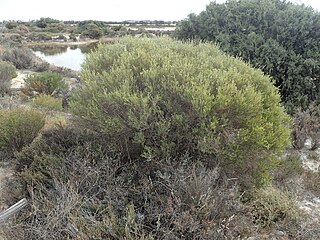
Melaleuca zeteticorum is a shrub in the myrtle family Myrtaceae and is endemic to the south-west of Western Australia. It is a shrub with narrow leaves and pale to bright yellow flowers in spring. Its species name zeteticorum was given "in honour of these persons who for their enjoyment explore natural vegetation communities to become familiar with their constituent species".

Melaleuca biconvexa is a tree or shrub in the myrtle family, Myrtaceae and is endemic to coastal areas of New South Wales. The leaves have a distinctive, wing-like shape and the flowers are in white or cream-coloured heads at the ends of its branches. It is classified as a vulnerable species.

Melaleuca cornucopiae is a shrub in the myrtle family Myrtaceae and is endemic to western Arnhem Land in the Northern Territory of Australia. It is distinguished by it unusual flowering spike - a horn-like structure covered by overlapping bracts with the flowers opening in succession, starting from the bottom of the spike.
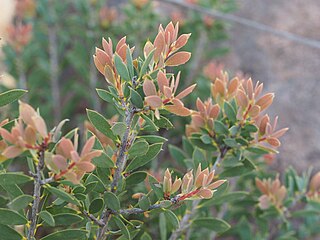
Melaleuca deanei, commonly known as Deane's paperbark, is a plant in the myrtle family, Myrtaceae and is endemic to New South Wales in Australia. It is a shrub with flaky bark, narrow oval leaves and spikes of white flowers in spring and summer. The species only exists in a few isolated populations and is classified as vulnerable.
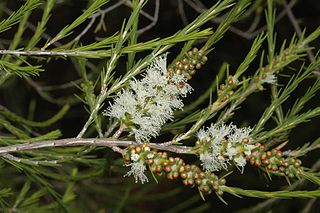
Melaleuca densispicata is a plant in the myrtle family Myrtaceae and is native to Queensland and New South Wales in Australia. It is a dense, woody shrub or tree with papery or scaly bark, sharp pointed leaves and dense flower spikes. It is uncommon throughout its range and was not formally described until 1984.

Melaleuca groveana, commonly known as Grove's paperbark is a plant in the myrtle family Myrtaceae and is endemic to New South Wales and Queensland in Australia. It is an uncommon species with relatively large heads of white flowers in spring, the styles of which are significantly longer than the stamens.

Melaleuca irbyana, commonly known as weeping paperbark, bushhouse paperbark and swamp paperbark, is a plant in the myrtle family Myrtaceae and is endemic to New South Wales and Queensland in Australia. It is a shrub or small tree, often growing in pure stands in poorly drained areas. Its distribution is limited and it has been classified as an endangered species under legislation in both states and the forest as critically endangered under Australian government legislation.

Melaleuca macronychia is a shrub in the myrtle family Myrtaceae, endemic to the south-west of Western Australia. Its large, red flower spikes and long flowering period contribute to its popularity as a garden plant. There are two subspecies, distinguished mainly by the shape of the leaves.
Melaleuca ochroma is a plant in the myrtle family, Myrtaceae, and is endemic to the south-west of Western Australia. It is very similar to Melaleuca subfalcata, varying mainly in the length of its stamens and styles. Like M. subfalcata, it has pink to mauve flowers and leaves that are very hairy when young but become glabrous when mature.

Melaleuca pallescens is a plant in the myrtle family, Myrtaceae, and is endemic to the state of Queensland in Australia. It has hard, furrowed bark and very small leaves that have the lower part of their upper surface pressed against the branches of the plant.

Melaleuca parvistaminea is a plant in the myrtle family, Myrtaceae, and is endemic to the states of New South Wales and Victoria in Australia. It has hard, rough bark, cream coloured flowers and leaves in whorls of three around the stems.

Melaleuca punicea is a plant in the myrtle family, Myrtaceae, and is endemic to the Northern Territory in Australia. Some of the characteristics of this species make it difficult to classify at the genus level. After it was originally described in 1984 as Melaleuca punicea, it was transferred in 1986 to the genus Regelia but it did not fit well in that genus either. In 1999 it was transferred again to a new genus Petraeomyrtus as P. punicea. Subsequent molecular studies, especially of chloroplast DNA have suggested that it is best placed in Melaleuca along with others from genera including Beaufortia, Callistemon and Regelia. Later publications include this species as Melaleuca punicea.
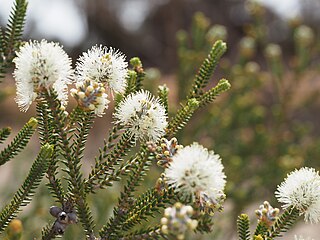
Melaleuca quadrifaria, commonly known as limestone honey-myrtle, is a plant in the myrtle family, Myrtaceae, and is native to the south of Western Australia. It is distinguished by the small size and arrangement of its leaves combined with its small spikes of white or cream flowers.
Melaleuca sericea is a plant in the myrtle family, Myrtaceae, and is endemic to the north of Western Australia and the north-west of the Northern Territory. It is a paperbark similar to Melaleuca dealbata but its leaves are covered with silky hairs, the flowers are whitish by comparison and it does not grow as tall as that species.
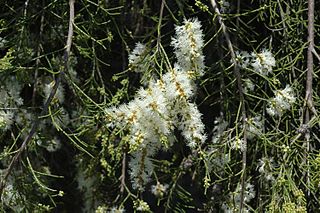
Melaleuca tamariscina, commonly known as bush-house paperbark or tamarix honey-myrtle is a plant in the myrtle family, Myrtaceae and is endemic to central Queensland in Australia. It grows to the height of a small tree with small, scale-like leaves that are pressed against the branches, and has a papery bark and a weeping habit.

Melaleuca tortifolia is a plant in the myrtle family, Myrtaceae and is endemic to a small area on the Northern Tablelands of New South Wales in Australia. It has egg-shaped, twisted leaves and heads, or short spikes of white or creamy-white flowers in December. It is classified as a threatened species.

















